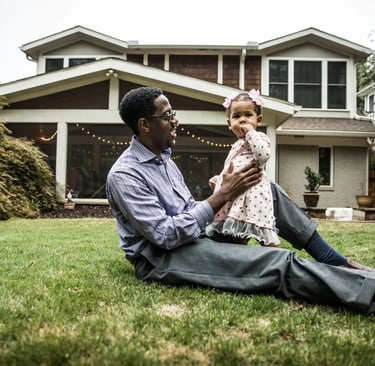Closing the Gap: The Real Story Behind Homeownership and Racial Wealth Inequality
This article breaks down the hard truth about the racial Wealth gap in America. We discuss how homeownership became a tool for wealth building, who it excluded, and why it still matters today. We explore systemic barriers, financial disparities, and what it'll take to close the gap for good. If equity and empowerment matter to you, this is required reading.
Jay Boone
4/9/20253 min read


Let’s get real: owning a home isn’t just about a white picket fence or a sense of pride—it’s the cornerstone of wealth in America. But that cornerstone has been handed out unevenly, and the result is a deep, persistent racial wealth gap that still defines our economy today. At the heart of that gap? Homeownership.
Our mission is rooted in empowering minority and urban communities to build wealth and reclaim economic power. And we know that closing the homeownership gap is one of the most direct paths to making that happen.
Why Homeownership Matters—More Than You Think
Owning a home gives you more than a roof—it gives you leverage. You can build equity, ride out rising rents, benefit from tax breaks, and grow your net worth in a way that renting simply can’t match. For the average household not sitting at the top 10% of wealth, their biggest asset is their home—not stocks, not business income, not retirement funds.
Yes, there are drawbacks—like high upfront costs, limited flexibility, and being tied to local job markets—but the long-term financial upside has consistently outweighed those risks. That’s why homeownership has been incentivized by government policies for decades. But here’s the kicker: those incentives weren’t equally available to everyone.
The Numbers Don’t Lie
Right now, 75% of white households own homes. Compare that to 45% of Black households, 49% of Hispanic households, and 57% of other non-white households. These numbers have barely moved since the 1970s—despite the passage of the Fair Housing Act in 1968. That’s over 50 years of so-called progress with little actual movement.
Yes, 2024–2025 has shown a promising bump in Black homeownership rates—but we need to push harder to ensure it’s not just a spike, but a sustained shift.
Wealth Starts Early—and So Does the Gap
The gap isn’t just wide—it’s generational. White families across every age bracket have homeownership rates at least 10% higher than Black and Hispanic families. That’s not just about access—it’s about opportunity compounding over time.
When you own a home early, your equity grows. You gain financial stability. You can borrow against it for your kids’ education, a business, or retirement. But when minority households are blocked from entering the market early—or ever—they’re denied that critical wealth-building runway.
How We Got Here: A System Built to Exclude
The roots of the gap are tangled deep in systemic racism. In the 1930s, federal housing policy openly excluded Black neighborhoods. Redlining didn’t just deny people homes—it denied them futures. And those effects didn’t die with Jim Crow—they echo today.
Modern discrimination is quieter, but just as deadly. Black and Hispanic borrowers still face more mortgage denials, higher interest rates, and worse loan terms—even when their credit and income are identical to white borrowers. And while overt redlining is outlawed, appraisal bias, predatory lending, and unequal down payment support keep the playing field uneven.
Not All Homes Are Equal
Even when Black and Hispanic households do own homes, they often don’t build wealth the same way. Why? Because the homes are undervalued. Because the neighborhoods don’t appreciate. Because systemic bias creeps into everything—from inflated property taxes to deflated appraisals.
A white-owned home, on average, is worth 2.5x more than a Black-owned home—and that stat hasn’t budged since 1970. Worse still, housing returns (the profit after owning and selling) are lower for Black and Hispanic homeowners than white ones by as much as 3.7 percentage points. That’s stolen equity in slow motion.
Foreclosures: The Silent Wealth Killer
When the economy crashes, Black and Hispanic families lose more. During the Great Recession, foreclosure rates spiked for minority households while barely moving for whites. The result? A devastating loss of equity—up to 70% for some Hispanic families.
This wasn’t just bad luck. Minority communities were targeted with high-risk mortgages and stripped of financial stability through predatory lending. And even today, inconsistent income and lack of liquid savings keep these communities vulnerable to another round of financial wipeouts.
The Wealth Divide Gets Worse With Age
As people get older, the wealth gap only widens. A white homeowner under 35 has $30K more in housing equity than their Black or Hispanic counterpart. By retirement, that gap explodes to over $175K. That’s the difference between leaving a legacy and leaving debt.
Where We Go From Here
If we want to close the racial wealth gap, we have to stop dancing around the issue. Homeownership is the battlefield—and we’ve got to put in work.
We need policies that make real ownership accessible: down-payment support, appraisal reform, and mortgage systems that don’t punish people for their race or zip code. But more than that, we need economic systems—education, employment, credit—that don’t stack the deck before a family even applies for a loan.
Homeownership isn’t just a goal—it’s a generational weapon. And if we can put that weapon into the hands of those historically shut out, we won’t just build wealth—we’ll shift power.